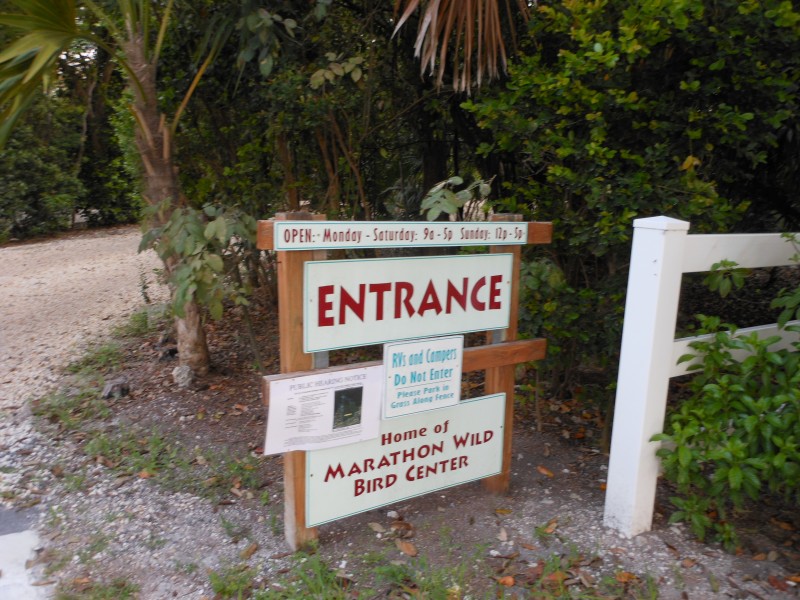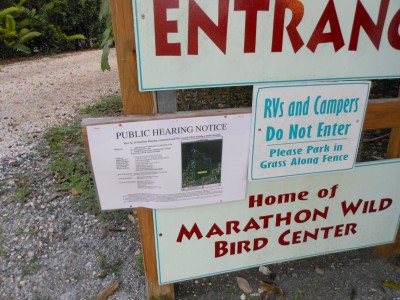Chaotic Planning Commission Meeting Decides Nothing
A much anticipated Marathon Planning Commission session that was to help decide the fate of a conditional use permit for construction of a zip-line attraction at Crane Point Hammock dissolved into chaos on Monday.
After presentations by Crane Point, the city, and a few citizens, George Chartrand, a resident of nearby 52nd Street, rose to object that the Florida Keys Land and Sea Trust that operates Crane Point Hammock had not properly advertised the planning meeting. He indicated that, while the city code requires 4 square foot signs around the property and in the neighborhoods affected, the Trust had posted signs that are only 11 inches by 17 inches and only in front of the nature area. He displayed one of these posters at the session.
Section 102.10 of Marathon’s code of ordinances says, regarding requirements for posted notice that “Signs shall be a minimum of four (4) square feet.” And, “A notarized affidavit and photographic evidence shall be submitted to the Department within 72 hours after the posting, certifying that the signs were posted in compliance with the standards of this section.”
The Land and Sea Trust, already severely financially stressed, will have to pay the cost of re-posting the signs and sending out an additional mailing via certified mail.
Marathon’s contracted attorney, John Herin, confirmed the validity of Chartrand’s complaint but proposed a compromise: allow the large crowd of people who had gathered to testify at the Monday meeting, post new signs and then give any additional interested people an opportunity to return to a subsequent meeting and add further testimony.
Chartrand would have none of it and, eventually after motions were put forward, withdrawn, and then made again, the entire planning commission agreed with his position, adjourning until further notice. This action infuriated many in the crowd, acknowledged by planning commissioners to be the largest that had assembled in recent memory. Some are snowbirds who will be leaving the Keys before any rescheduled hearing and others had traveled some distance to attend. White-crowned pigeon expert Dr. Ken Meyer had driven from Gainesville just to speak against the proposed project.
What made matters even worse is that the Land and Sea Trust board member Norval Smith had signed an affidavit attesting to the fact that they had properly advertised the meeting via the posted signs but planning director George Garrett and city planner Kevin Sullivan had accepted the affidavit without bothering to check the signs which were displayed right on U.S. 1 in front of the conservation area.
The cancellation, in effect, wiped the slate clean and the process will start from scratch. All presenters, including the city, Crane Point’s consultant Barbara Mitchell, and local citizens will be required to return at a date to be determined and present their testimony to the planning commission as if the Monday meeting had never happened. Attorney Herin agreed that those who can’t return might be able to give power of attorney to someone else to deliver their planned remarks.
Mitchell may, in fact, be relieved by the turn of events because her presentation was severely marred by poor preparation. She had forgotten some slides and had to rely on Garrett to provide them. These were projected rather poorly by a backup projector, obscuring the map of the planned path of the zip line and making it very difficult for those in the audience to see. This lack of preparation is surprising given the fact that Crane Point has been working on this plan since 2009.
Now Crane Point and the city must schedule another meeting, re-advertise the session, produce new signs and post them. All that must happen at least 15 days before another planning commission session. The kerfuffle will likely necessitate the postponement of a subsequent city council meeting to actually rule on the conditional use permit since the planning commission only recommends but doesn’t decide the fate of conditional use permits.

